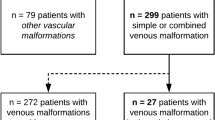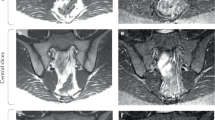Abstract
Sciatica is a set of symptoms rather than a specific diagnosis, and is caused by a herniated lumbar disc in the vast majority of cases. The most important symptom is lower limb pain radiating below the knee and into the foot and toes. The clinical course of acute sciatica is generally favorable, with most pain and related disability improving within 2–4 weeks with or without treatment. Diagnosis mainly involves history taking and physical examination. Imaging is warranted if there is evidence of an underlying pathology other than disc herniation, such as infection or malignancy, and in patients with severe symptoms that do not improve after 6–8 weeks of conservative treatment. MRI is the preferred imaging modality, as it can visualize soft tissues better than CT and does not expose the patient to ionizing radiation. Conservative treatment is generally the first-line option in patients with sciatica; however, the currently available evidence does not show any intervention—including a broad range of conservative and surgical approaches—to have clearly superior outcomes. Thus, patient preference seems to be an important factor in the clinical management of sciatica.
Key Points
-
Most patients who present with acute sciatica have a good prognosis, with pain and disability usually improving within 2–4 weeks with or without treatment
-
MRI is the preferred option if imaging is considered necessary, for example in patients who do not improve after 6–8 weeks of conservative therapy
-
Conservative treatment is the first-line option and should include an active approach, with patients being reassured and advised to continue their daily activities as much as possible
-
Early surgery after 6–12 weeks of sciatic pain gives faster recovery than prolonged conservative treatment with delayed surgery, but the 1-year prognosis is similar for both management strategies
-
None of the newer minimally invasive surgical techniques has clinically relevant benefits over standard open microdiscectomy in patients with sciatica
This is a preview of subscription content, access via your institution
Access options
Subscribe to this journal
Receive 12 print issues and online access
$209.00 per year
only $17.42 per issue
Buy this article
- Purchase on Springer Link
- Instant access to full article PDF
Prices may be subject to local taxes which are calculated during checkout

Similar content being viewed by others
References
Koes, B. W., van Tulder, M. W. & Peul, W. C. Diagnosis and treatment of sciatica. BMJ 334, 1313–1317 (2007).
Fairbank, J. C. Sciatica: an archaic term. BMJ 335, 112 (2007).
Bombardier, C, Esmail, R. & Nachemson, A. L. The Cochrane Collaboration Back Review Group for spinal disorders. Spine (Phila. Pa 1976) 22, 837–840 (1997).
Bouter, L. M., Pennick, V. & Bombardier, C. Cochrane Back Review Group. Spine (Phila. Pa 1976) 28, 1215–1218 (2003).
Hagen, K. B., Hilde, G., Jamtvedt, G. & Winnem, M. Bed rest for acute low-back pain and sciatica. Cochrane Database of Systematic Reviews, Issue 4. Art. No.: CD001254. doi: 10.1002/14651858.CD001254.pub2 (2004).
Clarke, J. A. et al. Traction for low-back pain with or without sciatica. Cochrane Database of Systematic Reviews, Issue 1. Art. No.: CD003010. doi: 10.1002/14651858.CD003010.pub4 (2007).
Gibson, J. N. & Waddell, G. Surgical interventions for lumbar disc prolapse. Cochrane Database of Systematic Reviews, Issue 2. Art. No.: CD001350. doi:10.1002/14651858.CD001350.pub4 (2007).
Ostelo, R. W., Costa, L. O., Maher, C. G., de Vet, H. C. & van Tulder, M. W. Rehabilitation after lumbar disc surgery: an update Cochrane review. Spine (Phila. Pa 1976) 34, 1839–1848 (2009).
Konstantinou, K. & Dunn, K. M. Sciatica: review of epidemiological studies and prevalence estimates. Spine (Phila. Pa 1976) 33, 2464–2472 (2008).
Raj, P. P. Intervertebral disc: anatomy-physiology-pathophysiology-treatment. Pain Pract. 8, 18–44 (2008).
Jensen, M. C. et al. Magnetic resonance imaging of the lumbar spine in people without back pain. N. Engl. J. Med. 331, 69–73 (1994).
Modic, M. T. et al. Acute low back pain and radiculopathy: MR imaging findings and their prognostic role and effect on outcome. Radiology 237, 597–604 (2005).
Weber. H., Holme, I. & Amlie, E. The natural course of acute sciatica with nerve root symptoms in a double-blind placebo-controlled trial evaluating the effect of piroxicam. Spine 18, 1433–1438 (1993).
Vroomen, P. C. A. J., de Krom, M. C., Slofstra, P. D. & Knottnerus, J. A. Conservative treatment of sciatica: a systematic review. J. Spinal Disord. 13, 463–469 (2000).
Legrand, E., Bouvard, B., Audran, M., Fournier, D. & Valat, J. P. Sciatica from disk herniation: medical treatment or surgery? Joint Bone Spine 74, 530–535 (2007).
Miranda, H., Viikari-Juntera, E., Martikainen, R., Takala, E. P. & Riihimaki, H. Individual factors, occupational loading, and physical exercise as predictors of sciatic pain. Spine (Phila. Pa 1976) 27, 1102–1109 (2002).
Younes, M. et al. Prevalence and risk factors of disk-related sciatica in an urban population in Tunisia. Joint Bone Spine 73, 538–542 (2006).
Kaila-Kangas, L. et al. History of physical work exposures and clinically diagnosed sciatica among working and nonworking Finns aged 30 to 64. Spine (Phila. Pa 1976) 34, 964–969 (2009).
Vroomen, P. C., de Krom, M. C. & Knottnerus, J. A. Diagnostic value of history and physical examination in patients suspected of sciatica due to disc herniation: a systematic review. J. Neurol. 246, 899–906 (1999).
Devillé, W. L., van der Windt, D. A., Dzaferagic, A., Bezemer, P. D. & Bouter, L. M. The test of Lasègue: systematic review of the accuracy in diagnosing herniated discs. Spine (Phila. Pa 1976) 25, 1140–1147 (2000).
Jarvik, J. G. & Deyo, R. A. Diagnostic evaluation of low back pain with emphasis on imaging. Ann. Intern. Med. 137, 586–597 (2002).
Govind, J. Lumbar radicular pain. Aust. Fam. Physician 33, 409–412 (2004).
Awad, J. N. & Moskovich, R. Lumbar disc herniations: surgical versus nonsurgical treatment. Clin. Orthop. Relat. Res. 443, 183–197 (2006).
Hagen, K. B., Jamtvedt, G., Hilde, G. & Winnem, M. F. The updated Cochrane review of bedrest for low back pain and sciatica. Spine (Phila. Pa 1976) 30, 542–546 (2005).
Luijsterburg, P. A. J. et al. Effectiveness of conservative treatments for the lumbosacral radicular syndrome: a systematic review. Eur. Spine J. 16, 881–899 (2007).
Luijsterburg, P. A. et al. Physical therapy plus general practitioners' care versus general practitioners' care alone for sciatica: a randomised clinical trial with a 12-month follow-up. Eur. Spine J. 17, 509–517 (2008).
Goupille, P., Mulleman, D., Paintaud, G., Watier, H. & Valat, J. P. Can sciatica induced by disc heriation be treated with tumor necrosis factor α blockade? Arthritis Rheum. 56, 3887–3895 (2007).
Korhonen, T. et al. The treatment of disc herniation-induced sciatica with infliximab: results of a randomised, controlled, 3-month follow-up study. Spine (Phila. Pa 1976) 30, 2724–2728 (2005).
Arts, M. P. et al. Tubular diskectomy vs conventional microdiskectomy for sciatica: a randomized controlled trial. JAMA 302, 149–158 (2009).
Ryang, Y., Oertel, M. F., Mayfrank, L., Gilsbach, J. M. & Rohde, V. Standard open microdiscectomy versus minimal access trocar microdiscectomy: results of a prospective randomized study. Neurosurgery 62, 174–181 (2008).
Weber, H. Lumbar disc herniation. A prospective study of prognostic factors including a controlled trial. Part I. J. Oslo City Hosp. 28, 33–61 (1978).
Weber, H. Lumbar disc herniation. A controlled prospective study with ten years of observation. Spine (Phila. Pa 1976) 8, 131–140 (1983).
Buttermann, G. R. Treatment of lumbar disc herniation: epidural steroid injection compared with discectomy. A prospective, randomized study. J. Bone Joint Surg. Am. 86, 670–679 (2004).
Osterman, H., Seitsalo, S., Karppinen, J. & Malmivaara, A. Effectiveness of microdiscectomy for lumbar disc herniation. Spine (Phila. Pa 1976) 31, 2409–2414 (2006).
Weinstein, J. N. et al. Surgical vs nonoperative treatment for lumbar disk herniation: the spine patient outcomes research trial (SPORT): a randomized trial. JAMA 296, 2441–2450 (2006).
Weinstein, J. N. et al. Surgical vs nonoperative treatment for lumbar disk herniation: the spine patient outcomes research trial (SPORT) observational cohort. JAMA 296, 2451–2459 (2006).
Peul, W. C. et al. Surgery versus prolonged conservative treatment for sciatica. N. Engl. J. Med. 356, 2245–2256 (2007).
Tullberg, T., Isacson, J. & Weidenhielm, L. Does microscopic removal of lumbar disc herniation lead to better results than the standard procedure? Results of a one-year randomized study. Spine (Phila. Pa 1976) 18, 24–27 (1993).
Lagarrigue, J. & Chaynes, P. Comparative study of disk surgery with or without microscopy. A prospective study of 80 cases [French]. Neurochirurgie 40, 116–120 (1994).
Henriksen, L., Schmidt, V., Eskesen, V. & Jantzen, E. A controlled study of microsurgical versus standard lumbar discectomy. Br. J. Neurosurg. 10, 289–293 (1996).
Katayama, Y. et al. Comparison of surgical outcomes between macro discectomy and micro discectomy for lumbar disc herniation: a prospective randomized study with surgery performed by the same spine surgeon. J. Spinal Disord. Tech. 19, 344–347 (2006).
Huang, T. J., Hsu, R. W., Li, Y. Y. & Cheng, C. C. Less systemic cytokine response in patients following microendoscopic versus open lumbar discectomy. J. Orthop. Res. 23, 406–411 (2005).
Zhang, C. et al. Microendoscopic discectomy, a less traumatic procedure for lumbar disk herniation. Chin. J. Traumatol. 10, 311–314 (2007).
Shin, D. A., Kim, K. N., Shin, H. C. & Yoon, D. H. The efficacy of microendoscopic discectomy in reducing iatrogenic muscle injury. J. Neurosurg. Spine 8, 39–43 (2008).
Righesso, O., Falavigna, A. & Avanzi, O. Comparison of open discectomy with microendoscopic discectomy in lumbar disc herniations: results of a randomized controlled trial. Neurosurgery 61, 545–549 (2007).
Hermantin, F. U., Peters, T., Quartararo, L. & Kambin, P. A prospective, randomized study comparing the results of open discectomy with those of video-assisted arthroscopic microdiscectomy. J. Bone Joint Surg. Am. 81, 958–965 (1999).
Dutch Society for Neurology. Clinical guideline: lumbosacral radicular syndrome [Dutch]. (Dutch Society for Neurology, Urecht, 2008).
Author information
Authors and Affiliations
Ethics declarations
Competing interests
The authors declare no competing financial interests.
Rights and permissions
About this article
Cite this article
van Tulder, M., Peul, W. & Koes, B. Sciatica: what the rheumatologist needs to know. Nat Rev Rheumatol 6, 139–145 (2010). https://doi.org/10.1038/nrrheum.2010.3
Published:
Issue Date:
DOI: https://doi.org/10.1038/nrrheum.2010.3
This article is cited by
-
Efficacy of acupuncture for sciatica: study protocol for a randomized controlled pilot trial
Trials (2021)
-
Nerve root block versus surgery (NERVES) for the treatment of radicular pain secondary to a prolapsed intervertebral disc herniation: study protocol for a multi-centre randomised controlled trial
Trials (2018)
-
Post-operative extra-spinal etiologies of sciatic nerve impingement
Skeletal Radiology (2018)
-
A method for quantitative measurement of lumbar intervertebral disc structures: an intra- and inter-rater agreement and reliability study
Chiropractic & Manual Therapies (2013)
-
Influence of preoperative leg pain and radiculopathy on outcomes in mono-segmental lumbar total disc replacement: results from a nationwide registry
European Spine Journal (2012)



